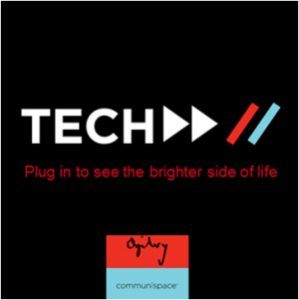Kids lead their parents in the adoption of digital technologies; that’s why the youngers are called Digital Natives. An intriguing survey of adults’ use of technologies finds that those who do so like “childlike play,” and at the same time, for kids, make them feel more grown up. The trend, Ogilvy says, is blurring generational lines: market to adults as kids, and kids as adults. This convergence is leading families to become more “units” — parents and kids increasingly on the same page in purchase decisions.
In Tech Fast Forward: Plug in to see the brighter side of life, from Ogilvy and Communispace, so called Tech Fast Forward families see a fairly optimistic future due to the findings that,
- People like power, and technology can help people harness that power for positive ends
- People believe in democracy, and technology can be an equalizer, breaking down information access barriers and connecting individuals in aggregate for shared platforms
- People like being positive, where optimism is “an attitude that we want,” more likely leading to success than pessimistic approaches.
Ogilvy segments the U.S. household populations into families that are:
- Tech backward, representing 3% – people who go out of their way to avoid technology
- Tech neutral, 36%, those less reliant on tech than the average family but have adopted tech on a basic level
- Tech forward, 42%, who have integrated technology in significant ways and can’t function well without the tech
- Tech fast forward, 19% of people, who use more sophisticated tech than average and are on the cutting edge of adoption.
Who are the tech fast forwards ? They’re more married, more male, more educated, Asian, affluent, not living in the Midwest, well-connected in networks both online and off-, influential in peer groups, in-the-know on trends and the new-new. Naturally, they tend to own more portable and personal technologies like gaming systems, iPhones, iPads and Flipcams, and they quite wired with satellite radio subscriptions. They engaged via mobile — using Kindles for reading and grabbing information on-the-go via mobile platforms.
? They’re more married, more male, more educated, Asian, affluent, not living in the Midwest, well-connected in networks both online and off-, influential in peer groups, in-the-know on trends and the new-new. Naturally, they tend to own more portable and personal technologies like gaming systems, iPhones, iPads and Flipcams, and they quite wired with satellite radio subscriptions. They engaged via mobile — using Kindles for reading and grabbing information on-the-go via mobile platforms.
The methodology for this study included two waves of a survey among 1,200 respondents conducted between October 2010 and April 2011 among adults 18-64 with at least one child between 3 and 12 years of age in the household.
Health Populi’s Hot Points: Moms (most of them) are the Chief Health Officers of their households. It’s nice to know that those who embrace technology are positive thinkers. It’s even more exciting, from a health standpoint, that those moms can take advantage of consumer technologies to benefit their and their families’ health.
What of the less-tech-embracing Moms? In these households, it’s safe to say that there will be health disparities and health challenges that could benefit from the families’ adoption of smartphones, health apps, and engaging tools to help manage kids’ chronic asthma and the revolving emergency room door; Type 1 diabetes being well-managed through self-tracking; and health-gamification of moving around and away from sedentary video games, using well-designed and fun! tracking tools beyond the generic, dullsville pedometer.
I’ve dug into the demographic of the tech fast forward segment, and am interested to find a bifurcation within the income segment: while the most affluent households with over $150K annual income over-index by 2-fold for tech fast forwards, I note that the population with less than $49K a year also over-indexes (at 113) — higher than people $50-99.9K (indexed at 84) and families with $100-$149K a year (indexed at 98).
Health marketers should intuit then that programs for self-tracking and -care aren’t limited to the most affluent population in the U.S. — and should not be. Engaging people to use consumer based tech’s they’re already using in other parts of their life is a huge opportunity to getting people activated for their health at home and out and about their communities.
Marketers of health services should take particular note in some of Ogilvy’s recommendations. Key implications include mining the family mindset, leveraging crowdsourcing, “being nice” (which goes a long way in the bedside-manner of health and medicine), turning up the intensity of shared experiences, getting serious about game play, and building gated communities (in health, for example, patient communities who can share experiences).





 Grateful to Gregg Malkary for inviting me to join his podcast
Grateful to Gregg Malkary for inviting me to join his podcast  This conversation with Lynn Hanessian, chief strategist at Edelman, rings truer in today's context than on the day we recorded it. We're
This conversation with Lynn Hanessian, chief strategist at Edelman, rings truer in today's context than on the day we recorded it. We're